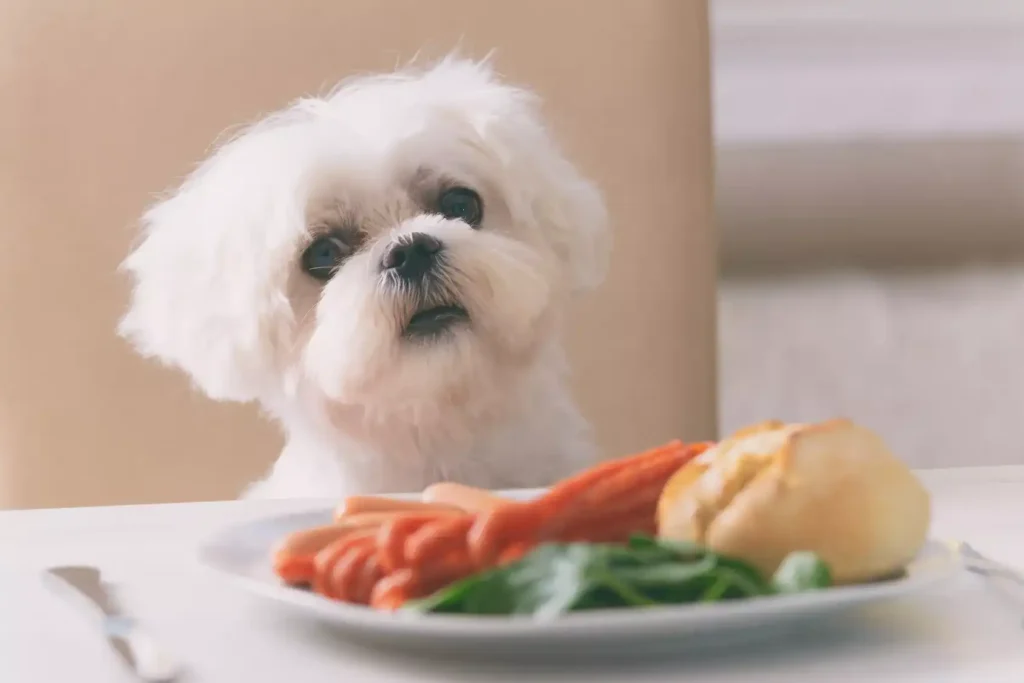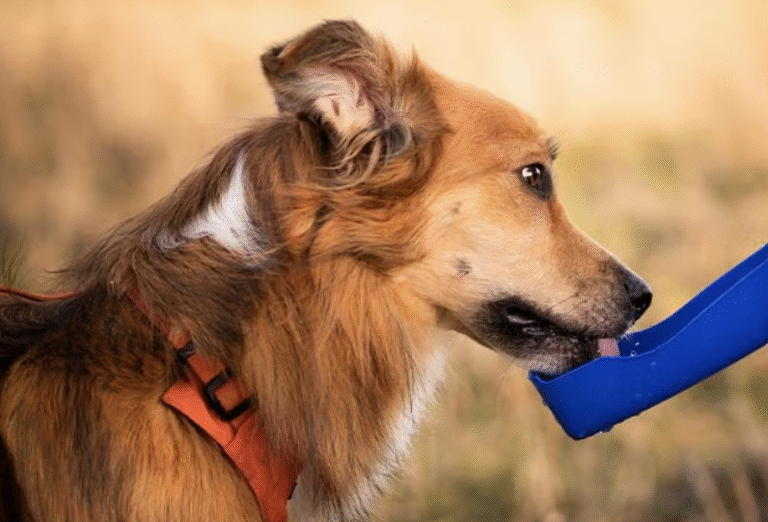Dangerous foods for dogs
Not everything that we humans eat is also suitable for our dogs. Sometimes even small amounts are enough to pose a danger, but other times it depends on the duration or preparation of the food. Get an overview of dangerous foods for dogs and which foods your dog can eat.

What foods are dangerous for dogs?
Although dogs have historically, and still do to some extent today, often eaten leftover food, of course only food that is good for them should end up in the dog bowl.
There is nothing stopping your dog from getting a little bit of “human food” every now and then. Some foods that we can eat without further ado are harmful or toxic to our four-legged friends. For this reason, it is a good idea to be aware of which foods can be dangerous for your dog.
Has your dog eaten something wrong? Go to the vet!
If, against all suspicion, your dog has eaten something poisonous or something it cannot tolerate, it is recommended to see a veterinarian immediately. The veterinarian will ask what and how much the dog has eaten, as well as how long ago the food was ingested. Based on this information, the veterinarian can then initiate appropriate treatment.
Unfortunately, sometimes help comes too late, which is why it is all the more important to prevent the consumption of foods that can be dangerous for your dog in the first place.
Build resilience against pleading dog stares
Be strong when your dog looks at you with his beautiful gaze. Although it may be difficult, you should develop a resistance to the beautiful dog gaze. Because what humans like to eat is no measure of a dog’s diet.
The same goes for things that dogs like to eat. Some dogs are very fond of food. They are unable to distinguish between good foods and foods that can be harmful or even fatal to them.
Foods that dogs should not eat
Below is a list of foods that are not suitable for dogs. This list is not intended to be exhaustive. In addition to those listed here, there may be other dangerous foods for dogs that could be harmful to your four-legged friend.
If you are unsure whether your dog has eaten something dangerous or is showing suspicious symptoms, you should go to the vet or an animal clinic.
The most common signs of poisoning are diarrhea and vomiting. In addition, some toxic foods can cause possible secondary damage or, depending on the amount, can even be fatal.
Fruits and vegetables that are dangerous for dogs
Onions and garlic
Onions, garlic and other allium plants are absolutely forbidden for dogs, as they contain substances that attack and destroy red blood cells.
Even a small amount of garlic or onions, namely 5 grams per kilogram of body weight, can be very toxic. This applies regardless of whether they are fried, boiled, raw or dried. For a 20 kilogram dog, a medium-sized onion or a head of garlic is sufficient.
Grapes and raisins
Grapes and raisins can be fatal to some dogs. It is not clear what causes them and which dogs become ill with symptoms of poisoning. In general, a dog can develop symptoms of poisoning from eating ten grams of grapes per kilogram of body weight, or less than three grams of raisins per kilogram of body weight.
The main symptoms are vomiting, lethargy and stomach cramps after just a few hours. Within 24 to 72 hours, kidney failure and ultimately death of the animal can occur.
Nuts
Nuts, especially walnuts and macadamia nuts, should not be given to dogs. These two types in particular can cause nerve and muscle damage. Here, 4 macadamia nuts are already enough for a 30-kilogram dog.
Depending on the size of the nuts, they can also cause intestinal obstruction if swallowed.
Raw pork, raw ham or salami should never end up in a dog’s stomach. Pigs can be infected with the Aujeszky virus without being detected. An infection is always fatal for dogs.
Leg
Poultry bones or cooked bones also have no place in a dog’s bowl. The cooking process makes the bones porous so they splinter very easily when chewed. The splinters can cause massive damage to the intestines or intestinal walls and result in serious internal bleeding.
Coffee and tea
Coffee, tea and other caffeinated foods can have fatal consequences for your dog’s nervous system. Caffeine or theine can cause heart palpitations, vomiting and restlessness within a few hours.
In the later stages, symptoms similar to chocolate poisoning or kidney problems and nerve damage occur. The minimum lethal dose is approximately seven coffee beans per kilogram of body weight.
Sweeteners, birch sugar and xylitol
Within 30 to 60 minutes, sweeteners, birch sugar and xylitol cause hypoglycemia (very low blood sugar levels). Without treatment, this results in seizures, coma and even death of the dog.
Depending on the dosage, acute liver failure can also occur. Depending on the xylitol content, just one to three pieces of chewing gum can be fatal for a 10-kilogram dog.
Chocolate and cocoa
Both chocolate and cocoa contain the substance theobromine, which is toxic to dogs. The darker the chocolate, the higher the theobromine content. The first symptoms appear after just a few hours. These include vomiting, restlessness and tremors. This is followed by seizures, breathing problems and heart palpitations. Ultimately, this leads to heart failure and the death of the animal.
Always try to find out how much chocolate your dog has eaten and contact your vet immediately. As little as 50 grams of dark chocolate can cause symptoms of poisoning in a 20-kilogram dog.
Foods that dogs should only eat in moderation
Plants from the nightshade family
Be extra careful with plants that belong to the nightshade family, such as tomatoes, eggplants, peppers and potatoes. Especially the green parts and sprouting potatoes contain a lot of solanine.
Potatoes and red or yellow peppers should therefore only be fed in cooked form. Tomatoes can be given to dogs raw, but only in small quantities. Be careful to remove the green parts beforehand. Symptoms of poisoning appear in the form of irritated mucous membranes, diarrhea and vomiting.
Mushroom
No one can say for sure how the ingredients in mushrooms will affect your dog’s body. They can damage organs, break down the blood, or cause cancer. For this reason, mushrooms should not be in your dog’s bowl.
Cabbage plants
Cabbage results in severe bloating and should therefore only be given to dogs in very small quantities and never in a raw state.
Beans and other legumes
Dogs should never eat beans or other legumes in their uncooked form. When raw, they contain a lectin that is harmful to both humans and dogs. This leads to vomiting, stomach cramps, and bloody diarrhea.
What other foods should dogs only eat in moderation?
Avocado
Avocados contain the fatty acid derivative persin, which is harmless to humans but harmful to animals. The concentration of persin is particularly high in the peel and stone, but the flesh itself can also contain plenty of persin. The substance causes vomiting and diarrhea in dogs. The avocado stone can also cause intestinal torsion (ileus) if the dog swallows it.
Stone fruits / fruit kernels
Apricots, plums, cherries and peaches are among the fruits that are considered stone fruits. Stone fruit seeds contain hydrocyanic acid, which can be released when the stones are chewed. Hydrocyanic acid can cause serious neurological disorders. Stones that are swallowed whole can result in intestinal torsion (ileus).
Almonds
Like stone fruits, almonds also contain hydrocyanic acid. This can cause serious neurological disorders. Swallowing almonds whole can also result in intestinal torsion (ileus).
Alcohol
Dogs have a significantly lower tolerance for alcohol. At first or with small amounts, the symptoms are the same as in humans. Later or with larger amounts of alcohol, vomiting, difficulty breathing, coma and death will occur. Long-term consumption of small amounts of alcohol also leads to massive liver damage.
Raw eggs
Raw eggs inhibit the absorption of biotin. This substance is important for carbohydrate, protein and fat metabolism. In addition, raw eggs can pose a risk of salmonella infection.
Other dangerous foods for dogs
Foods that are too fatty or spicy are not well tolerated by dogs. This is because a dog’s metabolism is regulated differently than humans. This type of food can cause diarrhea or vomiting. In addition, foods that are very high in fat can, over time, lead to inflammation of the pancreas (pancreatitis).
Fruit often contains a lot of sugar. However, if your dog loves fruit, there is nothing stopping him from giving her a small piece of apple or banana every now and then, as long as the total amount is moderate.
Although salt itself is not toxic to dogs, the amount is crucial. You should be especially careful with older, sick or weak animals. Larger amounts of salt can damage the heart and kidneys.
Fish should only be fed in small quantities and never raw. The high protein and fat content of fish can cause vomiting and diarrhea in some dogs. Also, make sure there are no fish bones in the food.
Dairy products can cause stomach upset in some dogs who are lactose intolerant. This often results in severe diarrhea. For this reason, dogs should never be given pure milk and only small amounts of other dairy products (yogurt or quark).







One Comment